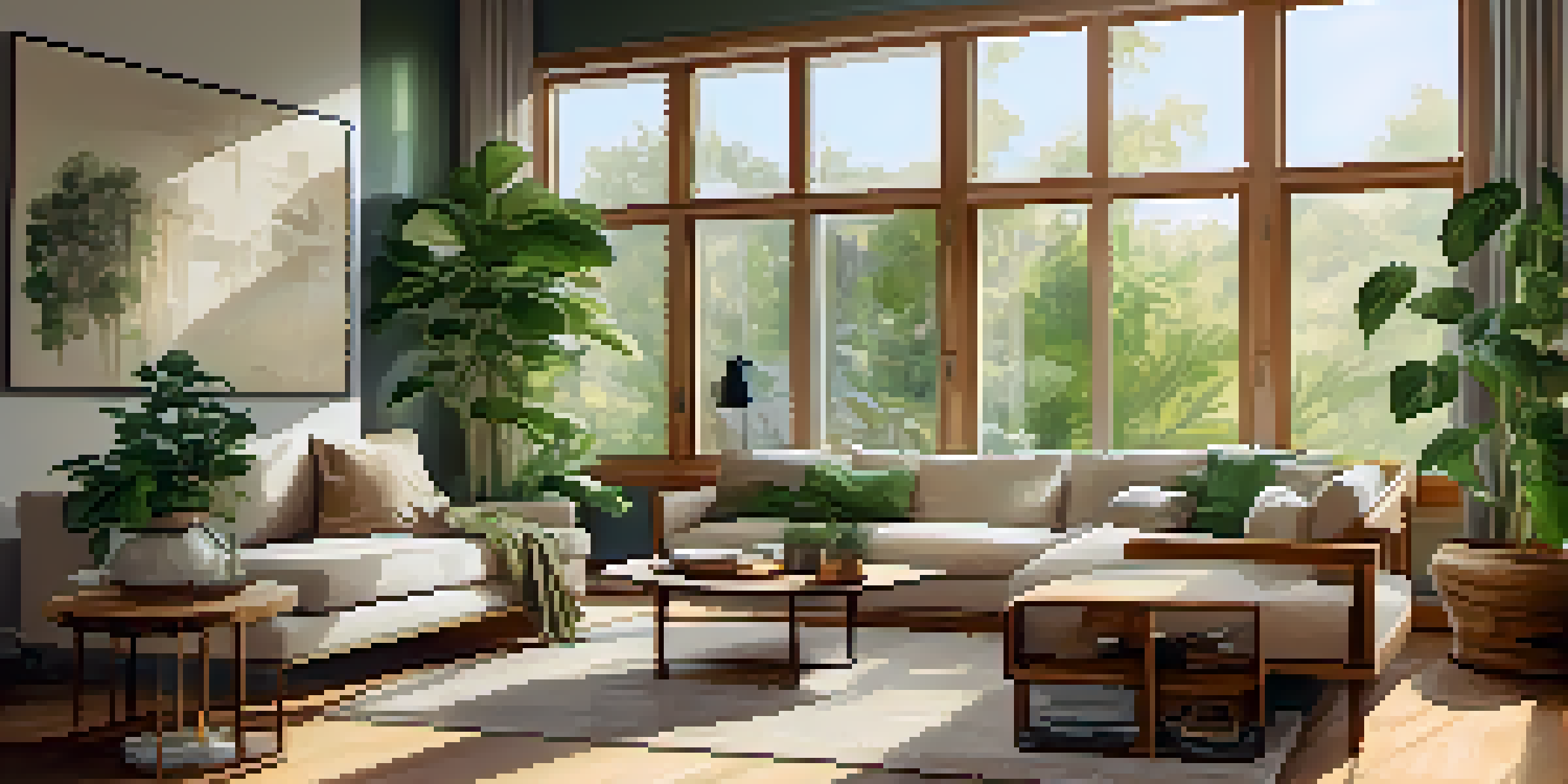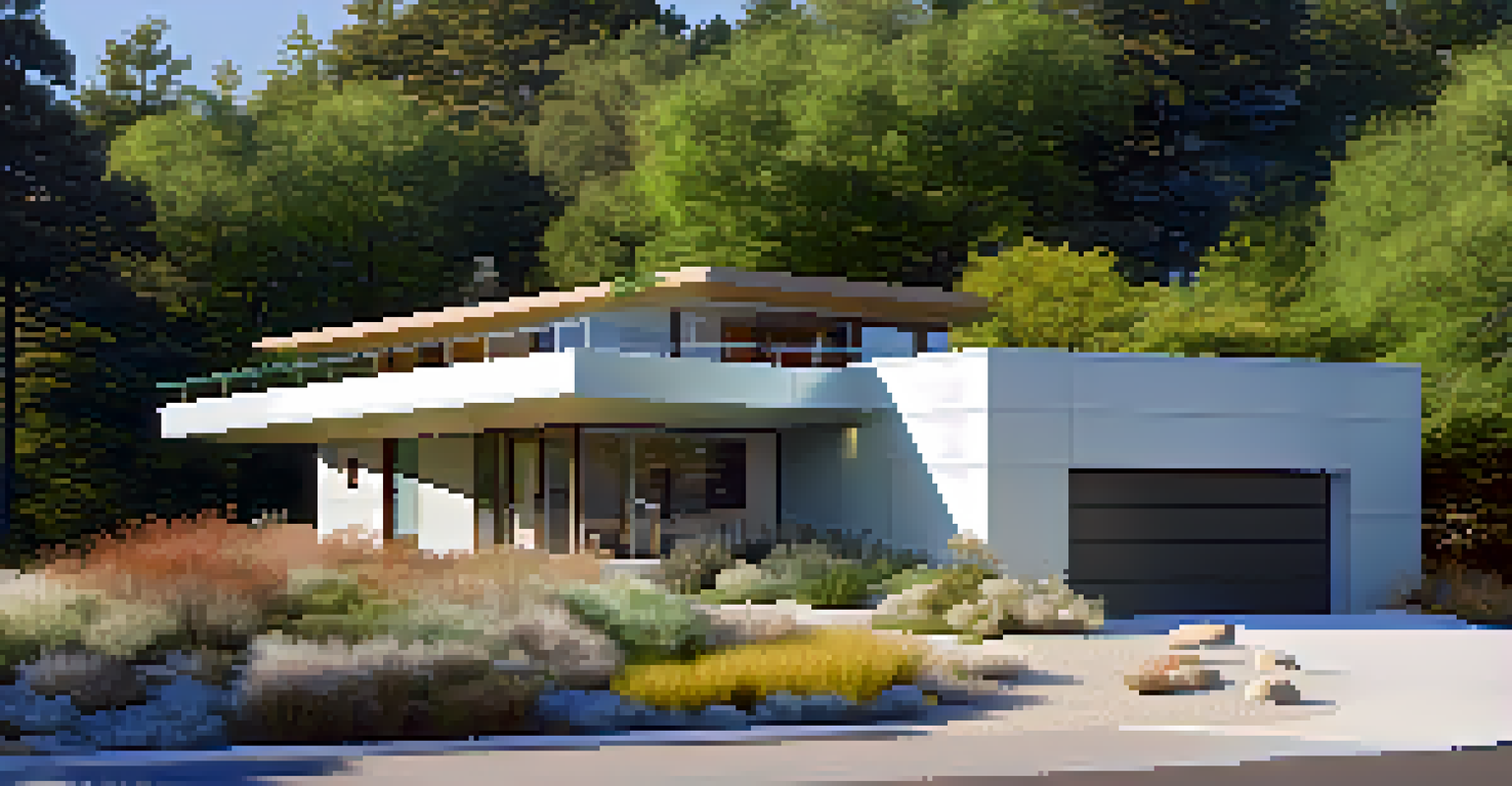Designing for Energy Efficiency: Key Considerations

Understanding Energy Efficiency in Design
Energy efficiency in design refers to creating spaces that use less energy while maintaining comfort and functionality. This concept is crucial in today’s world, where energy consumption significantly impacts both the environment and our wallets. By focusing on energy-efficient design, we can reduce carbon footprints and promote sustainable living.
The greatest threat to our planet is the belief that someone else will save it.
When designing with energy efficiency in mind, it's essential to consider factors like insulation, window placement, and the materials used. For instance, high-quality insulation can minimize heat loss in winter and keep spaces cool in summer, reducing the need for heating and air conditioning. Furthermore, strategically placed windows can maximize natural light while minimizing heat gain.
Ultimately, energy-efficient design not only benefits the environment but can also lead to long-term cost savings for homeowners and businesses alike. By making informed choices during the design process, we can create spaces that are both beautiful and sustainable.
Incorporating Sustainable Materials
Choosing sustainable materials is a cornerstone of energy-efficient design. These materials are sourced responsibly and often have a lower environmental impact compared to conventional options. Examples include reclaimed wood, recycled metal, and low-VOC (volatile organic compound) paints that contribute to healthier indoor air quality.

Using sustainable materials can enhance a building's energy performance by improving insulation and reducing energy consumption. For instance, bamboo flooring is not only aesthetically pleasing but also a rapidly renewable resource that requires less energy to produce. This type of conscious material choice can play a significant role in achieving overall energy efficiency.
Energy Efficiency Benefits Us All
Prioritizing energy-efficient design can reduce environmental impacts and lead to long-term cost savings for homeowners and businesses.
Moreover, investing in sustainable materials often pays off in the long run. While the initial costs might be higher, the benefits of durability and lower maintenance needs can lead to significant savings over time.
Optimizing Natural Light and Ventilation
Natural light and ventilation are two critical components of energy-efficient design. By optimizing these elements, designers can reduce reliance on artificial lighting and mechanical heating or cooling. This not only conserves energy but also enhances the occupants' comfort and well-being.
Sustainability is not a destination, it is a journey.
For example, large windows, skylights, and open floor plans can facilitate better airflow and natural light distribution. This design approach reduces the need for daytime lighting and allows for passive cooling during warmer months. Incorporating features like operable windows can also encourage cross-ventilation, further enhancing indoor air quality.
Additionally, utilizing light-colored surfaces can help reflect natural light, making spaces feel brighter while reducing the need for electric lighting. By thoughtfully integrating natural light and ventilation, designers can create healthier, more inviting spaces.
Implementing Smart Technology Solutions
Smart technology is revolutionizing how we approach energy efficiency in design. With the rise of smart home devices, homeowners can monitor and control their energy consumption more effectively. This includes everything from smart thermostats that learn your schedule to energy-efficient lighting systems that can be controlled remotely.
These technologies allow for precise energy management, ensuring that systems are only active when needed. For instance, smart thermostats can adjust heating and cooling based on occupancy, significantly reducing unnecessary energy use. As a result, integrating these technologies into design can lead to considerable energy savings.
Sustainable Materials Matter
Using sustainable materials not only lowers environmental impact but also enhances energy performance and can result in significant savings over time.
Moreover, the data collected from smart devices can help inform future design decisions, encouraging continuous improvements in energy efficiency. As we embrace this technology, we can create more adaptive and intelligent living spaces.
Designing for Energy Performance Ratings
Energy performance ratings are essential for measuring and validating the energy efficiency of a building. These ratings, such as LEED (Leadership in Energy and Environmental Design) or ENERGY STAR, provide benchmarks that designers can aim for during the planning stages. Achieving these ratings can enhance a building’s marketability while promoting sustainability.
When designing for energy performance, it's crucial to understand the criteria involved. This includes elements like energy use intensity, on-site renewable energy generation, and water efficiency. By addressing these factors, designers can create spaces that meet or exceed performance standards.
Moreover, being certified with energy performance ratings can lead to financial incentives, such as tax breaks or grants, for builders and developers. This not only encourages sustainable practices but also signals a commitment to responsible design.
Considering Climate and Location Factors
Climate and location significantly influence energy-efficient design decisions. Understanding the local climate helps designers choose appropriate materials and systems that respond well to environmental conditions. For example, a home in a hot, humid climate may require different strategies than one in a cold, dry area.
Incorporating local climate considerations can lead to better energy performance. For instance, buildings in warmer regions might benefit from reflective roof materials and shade structures to reduce heat gain. Conversely, in colder climates, maximizing solar gain through south-facing windows can enhance heating efficiency.
Smart Tech Enhances Efficiency
Integrating smart technology in design allows for precise energy management, leading to considerable savings and informed future design choices.
Additionally, local flora and fauna can impact design choices, such as landscaping for natural cooling and windbreaks. By considering these factors, designers can create spaces that are not only energy-efficient but also harmoniously integrated with their surroundings.
The Role of Landscaping in Energy Efficiency
Landscaping plays a vital role in enhancing energy efficiency by providing natural shading and wind protection. Thoughtfully placed trees and shrubs can block harsh winds in winter and reduce the need for heating, while also cooling the surroundings during summer. This natural buffering can significantly lower energy costs for heating and cooling.
Moreover, landscaping can improve a building's overall aesthetic appeal while promoting biodiversity. Using native plants can create a sustainable ecosystem that requires less water and maintenance, further contributing to energy savings. This approach not only benefits the environment but also enhances the quality of life for occupants.

Incorporating green roofs and vertical gardens can also add layers of insulation, helping to regulate indoor temperatures. By integrating landscaping into energy-efficient design, we can create more sustainable and enjoyable living spaces.
Monitoring and Maintaining Energy Efficiency
Monitoring and maintaining energy efficiency is crucial for maximizing the benefits of energy-efficient design. Regular assessments can identify areas for improvement and help ensure that systems are operating at peak performance. Utilizing energy management systems can facilitate this process, providing real-time data on energy use.
For example, building owners can track energy consumption patterns and recognize potential inefficiencies or unexpected spikes in usage. This information can lead to proactive maintenance and adjustments, keeping energy costs in check. Furthermore, engaging occupants in energy-saving practices can create a culture of sustainability within the building.
Ultimately, ongoing monitoring and maintenance allow for continuous optimization of energy efficiency strategies. By fostering a commitment to energy stewardship, we can ensure that designed spaces remain sustainable and cost-effective for years to come.